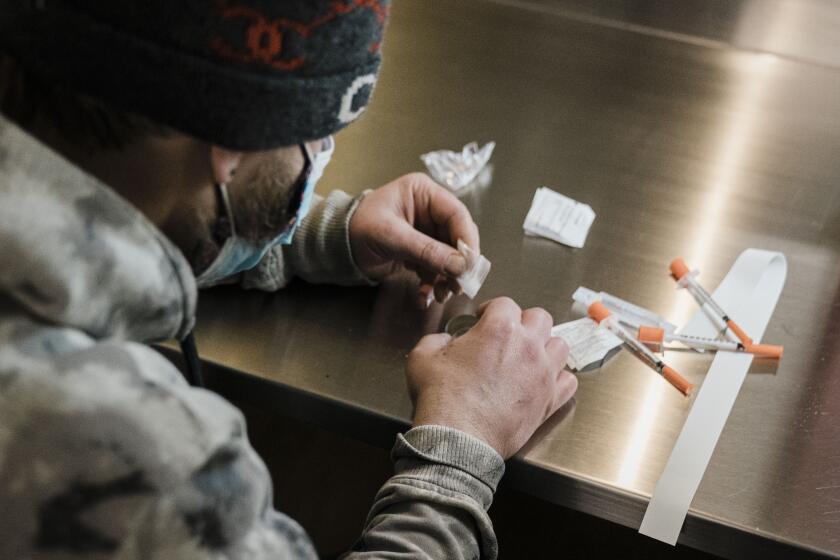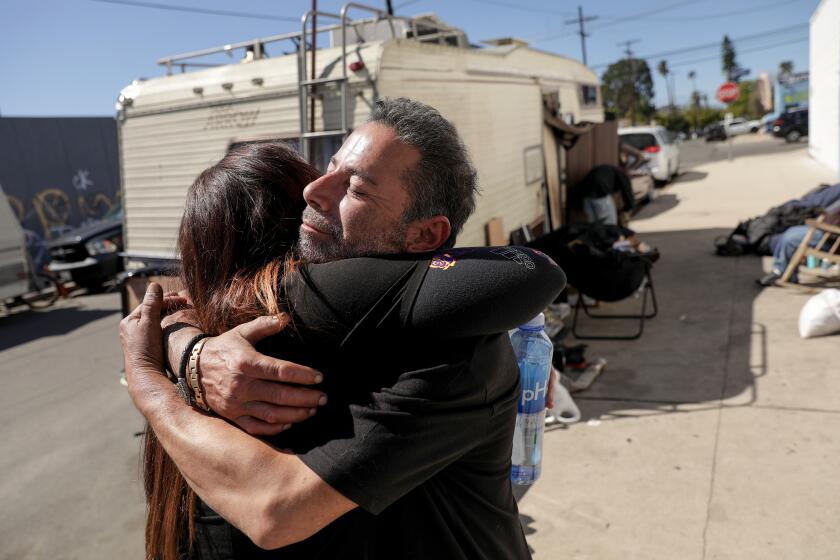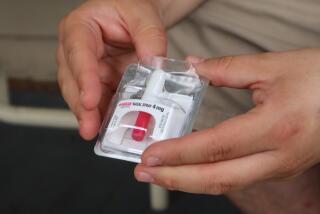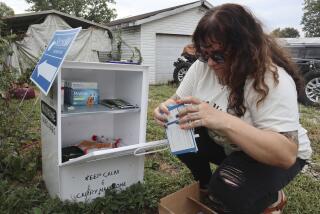‘This is not the end’: L.A. advocates say veto doesn’t shut door to safe injection sites
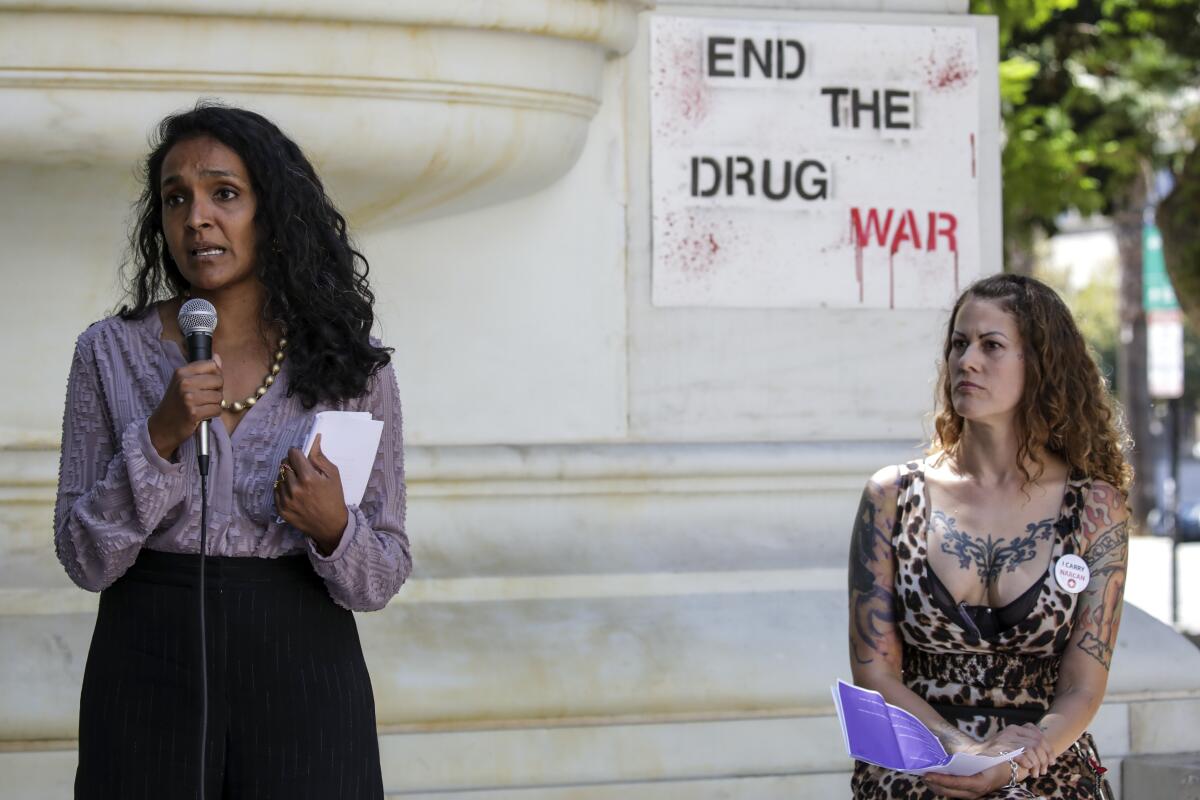
In the sweltering heat, activist Soma Snakeoil gripped the microphone and led the crowd outside Los Angeles City Hall in a chant.
“They talk! We die!” the crowd shouted. “They talk! We die!”
It was International Overdose Awareness Day and dozens of people had gathered downtown to mourn and rage, lighting candles, laying down roses and planting purple flags in the City Hall lawn to remember the dead. At the microphone, harm reduction advocates demanded government action and investment in stopping overdose deaths as the annual toll has exceeded 10,000 statewide.
“As far as the governor,” West Covina resident Debbie Fracasso said, growing emotional after stepping up to the microphone, “what part of this doesn’t he see?”
The rally came the week after Gov. Gavin Newsom vetoed a state bill that would have allowed supervised sites for people to inject drugs to be launched through pilot programs in Los Angeles, San Francisco and Oakland. The decision disappointed and enraged local activists who argue that such sites are desperately needed to save lives.
But it has not halted their plans, local officials and activists said.
“This is not the end,” said community activist Eunisses Hernandez, who supports the idea of safe injection sites and recently won election to the L.A. City Council. “This just gives us more direction on what our next steps are.”
Gov. Gavin Newsom faced a political challenge with Senate Bill 57, intended to curb overdose deaths in California through safe injection sites.
In San Francisco, City Atty. David Chiu said he would support a local nonprofit moving forward with such a site. San Francisco Mayor London Breed said that implementing overdose prevention programs is “a key step in our efforts to help people struggling with addiction” and “our efforts must continue.”
In Los Angeles, advocates and officials have been strategizing about what happens next.
“We knew that if something didn’t happen in Sacramento, we would need to figure something out,” said Ricky Rosales, AIDS coordinator for the city of Los Angeles. “It’s just a matter of us putting our ducks in a row and pushing this forward.”
Such safe consumption or overdose prevention sites have long been established in other countries as a way to prevent people from dying of overdoses. As deaths from drug overdoses have soared, claiming more than 100,000 lives annually across the country, the idea has started to gain traction in the United States as well.
Rhode Island lawmakers voted to legalize a pilot program. New York City backed the opening of the first authorized sites in the country, which are operated by a nonprofit, and city officials credit them with averting hundreds of overdoses.
Fracasso, who said she had wrenched free from her own addiction to heroin years earlier, argued that the idea of supervised injection sites had proved itself in New York and abroad. If Newsom is “nitpicking on little tiny things — come on,” she said of his veto. “Is nitpicking worth a life?”
A purple banner displayed at the rally declared “Every Overdose Death is a Policy Failure.”
Opponents of SB57 included a number of law enforcement associations, which argued that the idea put too little emphasis on treatment. The California Narcotic Officers’ Assn. argued that it “alarmingly concedes the inevitable and immutable nature of drug addiction and abuse.”
Newsom, in his veto message, said he was “acutely concerned about the operations of safe injection sites without strong, engaged local leadership and well-documented, vetted, and thoughtful operational and sustainability plans,” warning of “a world of unintended consequences.”
Despite his veto, Newsom signaled that he was still open to the idea if local officials returned to the Legislature with comprehensive plans for where they would be sited and how they would operate. The governor said he was directing the state health secretary to convene local officials to discuss standards for safe and sustainable programs.
New York is combating opioid overdoses with places where people can use drugs openly — a first in the United States.
If Newsom wants them to work with state officials, “I think we’re prepared to do that,” said Dr. Gary Tsai, director of the Substance Abuse Prevention and Control division at the Los Angeles County Department of Public Health. Tsai said that “alignment” among community groups, law enforcement and others “is the necessary ingredient for jurisdictions to move forward with something like safe consumption. And that’s something that’s going to take time.”
Shoshanna Scholar, director of the Harm Reduction and Community-Based Diversion division at the Los Angeles County Department of Health Services, said, “The bottom line is we need a legal pathway to support this overdose prevention program. Because we’re drowning.”
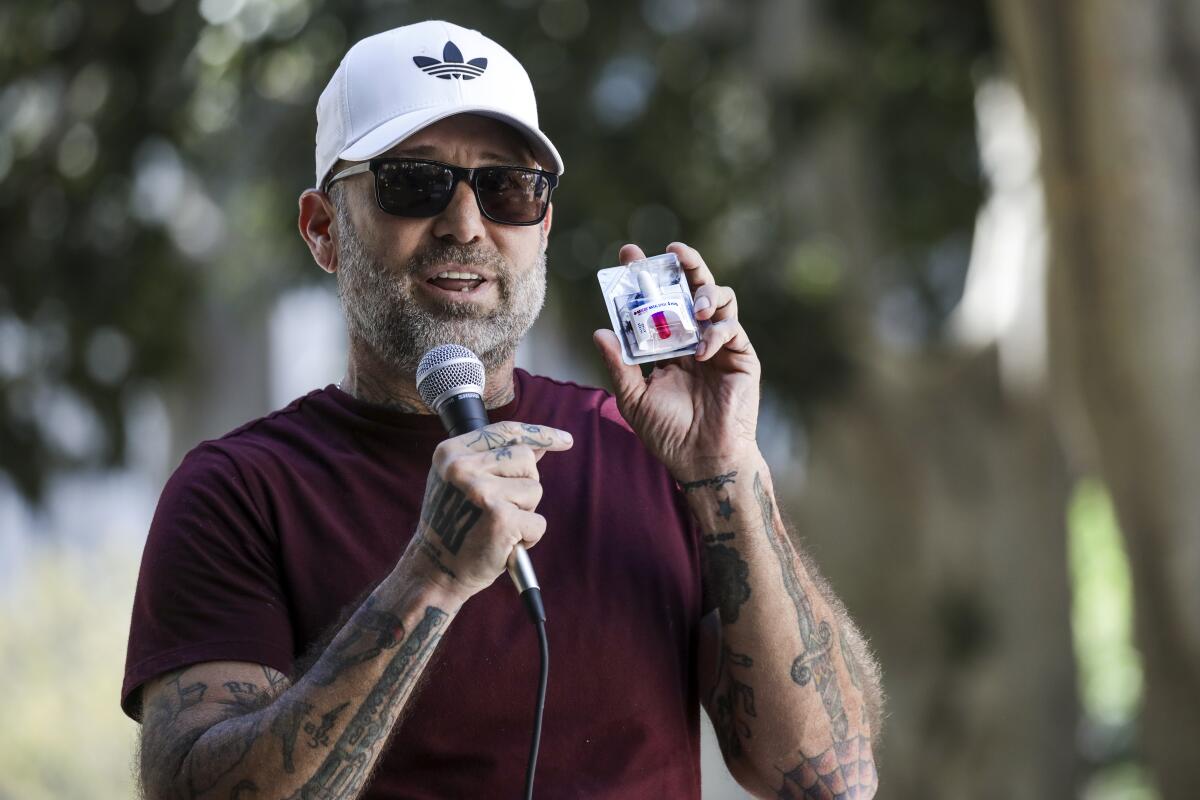
Last year, the Los Angeles Fire Department responded to more than 900 calls involving overdoses in the skid row area alone, according to data provided by an aide to Councilmember Kevin de León, who represents the area. At Wednesday’s rally, Renee Arellano-Stanisci told the crowd that she was hoping to save her son before he died.
Arellano-Stanisci, who works for the homelessness outreach and services agency HOPICS, said that before she escaped her own addiction to pills, she had suffered an opioid overdose that was reversed by paramedics using the medication naloxone. Her son, who is living in a riverbed, has overdosed twice — and each time was brought back to life by his friends, she said.
“I just want to be able to save somebody,” she said.
Los Angeles County Supervisor Hilda L. Solis said in a statement that “with a crisis this large, we must examine all effective tools to prevent needless death.”
The county supervisor added that although she had hoped SB57 would become law, she was “already in communication with our health departments so we can work with the state on a path forward, including minimum standards and best practices for safe and sustainable overdose prevention programs.”
Some advocates argue that Los Angeles could press ahead without the blessing of state officials and authorize such sites. In New York City, “they do not have state or federal authorization” for their overdose prevention centers, said Jeannette Zanipatin, California state director for the Drug Policy Alliance. “We’re in the same position now.”
Zanipatin said that “there is always the threat of federal intervention.” In Philadelphia, a nonprofit that sought to open an overdose prevention site was thwarted last year when a court ruled that such a site would violate a federal statute against opening up a property to others to use drugs.
Yet the U.S. Justice Department said in February that it was “evaluating” the idea of such sites. And so far, “the New York model has been running without any incident. The federal government hasn’t gone in and started to cite them,” Zanipatin said. “In the Biden administration, we’re seeing this opening to potentially have other jurisdictions follow New York’s model.”
With the federal government taking a hands-off approach, the state protection provided by a bill like SB57 “is nowhere near as obviously needed as it was before 2020,” said Peter Davidson, associate professor in the Department of Medicine at UC San Diego.
Rosales said that one possible option that has been discussed is declaring a local emergency over the overdose crisis. Los Angeles city officials made a similar declaration tied to the AIDS epidemic in 1994, directing city agencies “to immediately take all steps permitted by law to allow the availability and operation of responsible needle exchange programs.”
At the time, syringe programs could have risked criminal charges under laws targeting drug paraphernalia, Rosales said. Back then, the emergency declaration “provided us more flexibility to talk to LAPD and convince them that this was not something that they should go after us or our providers” for doing, Rosales said. “It was basically giving us cover from LAPD.”
“This would simply be the next step,” Rosales said of pursuing a new declaration to ease the way for overdose prevention sites.
Whether Los Angeles officials are ready to take that step is unclear.
When asked about whether Los Angeles Mayor Eric Garcetti supported any local action to authorize safe injection sites — including an emergency declaration — spokesperson Harrison Wollman responded with a written statement that Garcetti “looks forward to working with the county, governor, and state legislature on strategies in Los Angeles that can help save lives.”
To prevent overdose deaths, Los Angeles County health officials made a push to distribute 50,000 boxes of Narcan — a nasal spray that can block the effects of an opioid overdose — by this summer.
Councilmember Nithya Raman has been looking into the idea of an emergency declaration and what it would mean, her spokesperson Stella Stahl said. Raman, who spoke at the event outside City Hall, argued that there is firm evidence for safe injection sites and “we need to be leaning into exactly these kinds of solutions — not shying away from them for political reasons.”
But not everyone on the council is on board with the idea of launching the supervised sites, even though Los Angeles officially backed SB57 and sought to be included among cities that would pilot the programs. “The fact [that] we have a hard time protecting neighborhoods from open-air drug dens leads me to believe that we would also have a hard time managing all of the unintended consequences of supervised injection sites,” said Councilmember Joe Buscaino, who represents a district that includes Watts and San Pedro.
The upcoming elections have also stirred uncertainty into the political outlook, as voters decide in November who will succeed Garcetti as mayor.
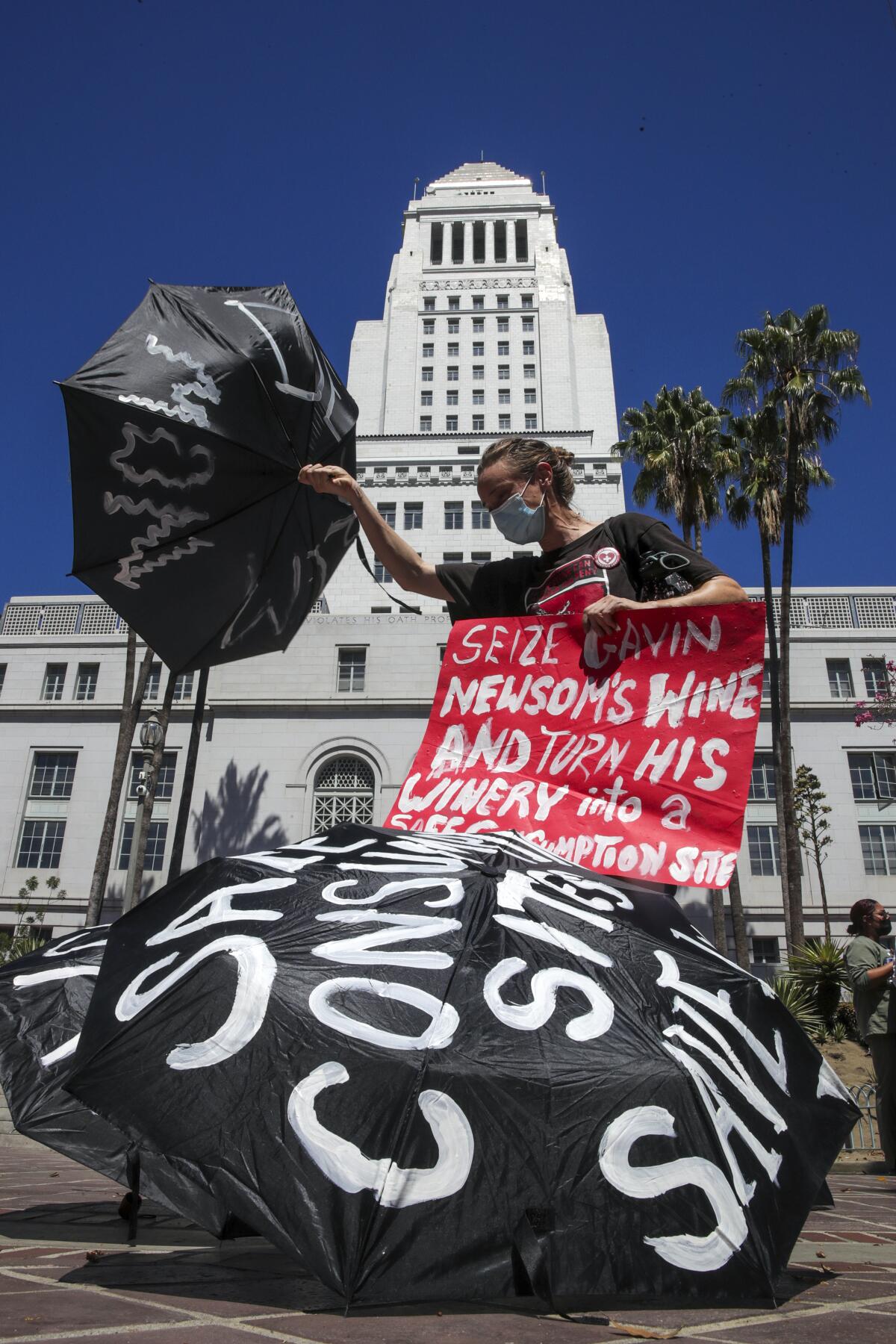
A spokesperson for Rep. Karen Bass, who is running for the seat, did not provide comment on her position on the state bill or whether L.A. should press forward with safe injection sites. Her opponent, real estate developer Rick Caruso, supported Newsom’s decision and rationale to veto SB57, campaign spokesperson Peter Ragone said.
Local voters will also choose whether to replace L.A. County Sheriff Alex Villanueva. His challenger, retired Long Beach Police Chief Robert Luna, said he agreed with Newsom’s veto of SB57 and “his explanation of a lack of infrastructure in place to locate and support such sites.” Villanueva opposed the state bill, saying the supervised sites would “only enable illegal and destructive drug use.”
Yet Scholar, asked about how the Sheriff’s Department fits into the ongoing discussions about supervised sites, called the agency “a true partner on overdose response.” By making naloxone available to reverse opioid overdoses in the county jails, Scholar said, “they now host the largest overdose prevention program in the world.”
Davidson, the UC San Diego professor, said that if local officials hesitate to authorize the sites, community groups may “just go ahead and quietly do it.” At least one underground site has been operating for years in the United States, at which Davidson and other researchers found that dozens of overdoses had been reversed with naloxone by trained staff.
At the underground site that Davidson studied, a director told him that “‘if we’d waited for official approval, the people we served would be dead,’” he recounted. “They just weren’t willing to do that.”
More to Read
Sign up for Essential California
The most important California stories and recommendations in your inbox every morning.
You may occasionally receive promotional content from the Los Angeles Times.
